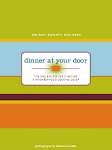By popular demand, I introduce to you the Coconut No-Bake Ball. It's edible, it's memorable, and it's just enough sweetness to hit the spot. Not to mention, it is packed full of much-desired lauric acid! Most of you know my healthy obsession with coconut oil because of all its anti-viral and anti-bacterial properties, so eating one of these coconut balls is kind of like getting a mini flu shot, but much much more enjoyable.
My husband is allergic to nuts, so instead of using almond butter we use sun butter, made from sunflower seeds. You can hardly tell the difference between peanut butter and sun butter, so it's a great substitute when recipes call for any kind of nut butter.
Makes 18, 1-inch balls
4 tablespoons melted coconut oil (raw and unrefined coconut oil)
4 tablespoons coconut milk
1 cup almond butter (or sun butter for nut allergies)
1/2 cup coconut flour
1/2 cup + 5 tablespoons unsweetened shredded coconut
2 tablespoons xylitol (or stevia if you prefer)
Add all ingredients except the 5 tablespoons shredded coconut to a turbo blender. Make sure to add the ingredients in the order listed above. The mixture will get pretty thick very fast, so you want your liquids at the bottom of the blender. Blend mixture and then pause to push sides of the mixture down with a spatula. Blend again if necessary. The mixture is going to be thick like cookie dough, so be prepared to keep an eye on your blender so the motor doesn't burn out. The mixture should be thoroughly blended, but not smooth.
Now roll dough into 1-inch balls and roll each ball in the reserved shredded coconut. Place coconut balls on a plate and refrigerate for at least 30 minutes before eating. Enjoy!
This recipe just so happens to be part of a candida cleanse, which I found on the Candida Diet website. Candida is a form of yeast found naturally in the intestine and the mouth. When you have an overgrowth of candida, it can make you get frequent colds and flus, feel lethargic or irritable, have chronic body pain, unable to focus, crave sugar or alcohol, unable to lose weight, and experience digestive problems. An overgrowth can happen with a slight change in your body, like going through a few rounds of antibiotics, eating a diet rich in carbs and sugars, or experiencing high stress. The Candida Diet website gives great background on what candida is, how an overgrowth effects your body, how to know if you have an overgrowth, and how to get rid of it.
You are meant to feel good! Listen to your body and do what it takes to get back to your natural state—health. There are so many resources out there to help you along the way!
Saturday, September 14, 2013
Friday, September 13, 2013
One Reason Not to Go Raw
Click on the images for a closer look. Are you surprised? It looks like if you're wanting more vitamin C, go for the raw kale, but if you're looking for an even more gargantuan amount of vitamin A, go for the cooked version.
What really caught my eye was the "Inflammatory Factor" numbers. Kale is already a highly anti-inflammatory green, but look at how that factor almost doubles when cooked. I had no idea! The lesson we learn, as always? Eat more kale. Eat more greens!
Just in case you're wondering why this information matters, stress causes inflammation and a whole lot of the foods we eat cause inflammation. People who deal with chronic or acute pain issues would do themselves good to eat more foods that are anti-inflammatory. I am always looking for ways to decrease the inflammation in my joints, so discovering this little secret about kale is huge. This morning, before I even made this discovery, I had some scrambled eggs cooked with garlic, bell pepper, and kale. Guess I'll be keeping that up and creating all kinds of new concoctions with cooked kale.
Go to Self Nutrition Data and type in chard and spinach (or any other food) to check out their nutrition facts and inflammatory factor.
(Out of curiosity I just looked up dandelion greens too. Same pattern of the nutrients skyrocketing when cooked. I'm going to have to look into this some more. Any insights? What is it that increases the anti-inflammatory property in greens when they are cooked? Time for me to do some research.)
Subscribe to:
Posts (Atom)




